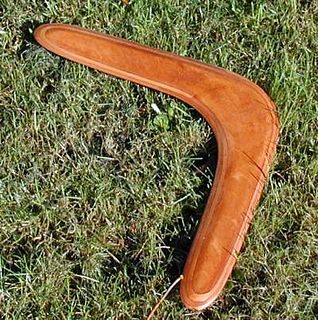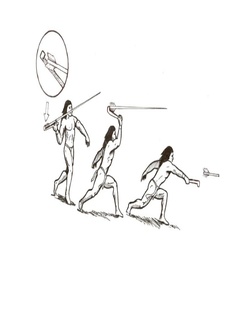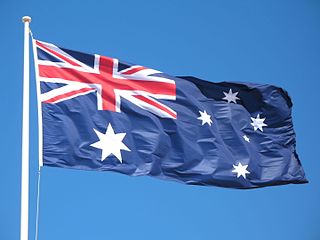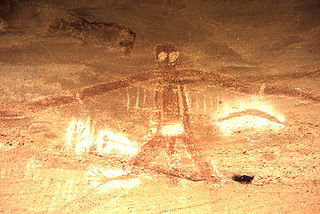
Australian Aboriginal artifacts consist the boomerangs, spears, shields, dillybags and other things Aboriginals had to carry around. Broadly aboriginal artifacts can be categorised as weapons, every day items and ritual or secret sacred objects. Many artifacts were devised to address the harsh living conditions in the Australian environment.

A boomerang is a thrown tool, typically constructed as a flat airfoil, that is designed to spin about an axis perpendicular to the direction of its flight. A returning boomerang is designed to return to the thrower. It is well known as a weapon used by Indigenous Australians for hunting.
A hielaman or hielamon is an Australian Aboriginal shield. Traditionally such a shield was made from bark or wood, but in some parts of Australia such as Queensland a hielaman is any shield.

A dillybag or dilly bag is a traditional Australian Aboriginal bag, generally woven from the fibres of plant species of the Pandanus genus.. It is used for a variety of food transportation and preparation purposes.
Contents
Many aboriginal artifacts were multi purpose for example boomerangs could be used for:
- as hunting or fighting weapons, [1]
- for digging,
- as cutting knives, [2]
- for making fire by friction and [3]
- as percussion instruments - music sticks. [4]
Weapons
The main forms of Aboriginal weapons include shields, spears, spear throwers, boomerangs and clubs. Aboriginal people from different regions used different weapons. [5] Some tribes for example would fight with boomerangs and shields where in another region they would fight with clubs.

A shield is a piece of personal armour held in the hand, which may or may not be strapped to the wrist or forearm. Shields are used to intercept specific attacks, whether from close-ranged weaponry or projectiles such as arrows, by means of active blocks, as well as to provide passive protection by closing one or more lines of engagement during combat.

A spear-thrower, spear-throwing lever or atlatl is a tool that uses leverage to achieve greater velocity in dart-throwing, and includes a bearing surface which allows the user to store energy during the throw.
These weapons were of different styles in different areas. For example, a shield from Central Australia is very different from a shield from North Queensland. [6]
Every day items
Every Day items include digging sticks, stone axes, coolamon and dilly bags. These items were mainly used in food gathering but were sometimes also used on ceremonial occasions.
Sacred Items
Sometimes the challenge overwhelmed both the people and their tools, so they needed an input from supernatural sources. Art was the mediator of these forces, not l'art pour l'art, i.e. art for art's sake - but practical strengthening of one's faith into oneself and the tool. Aboriginal art saturated these artifacts with sorcery and magic.[ citation needed ]
The best known of these sacred items are carved boards called Churinga Other sacred items used at ceremony include bullroarers and didgeridoo.

The bullroarer, rhombus, or turndun, is an ancient ritual musical instrument and a device historically used for communicating over great distances. It dates to the Paleolithic period, being found in Ukraine dating from 18,000 BC. Anthropologist Michael Boyd, a bullroarer expert, documents a number found in Europe, Asia, the Indian sub-continent, Africa, the Americas, and Australia.

The didgeridoo is a wind instrument. The didgeridoo was developed by indigenous peoples of northern Australia, likely within the last 1,500 years and is now in use around the world. It is a wooden trumpet "drone pipe" classified by musicologists as a brass aerophone.
Most aboriginal art is not considered to be an artifact but often the designs in aboriginal art were the same designs that were originally on sacred artifacts. [7] [8]
Even today, Aboriginal art is mostly sold as decoration on Aboriginal artifacts such as boomerangs, pottery, dillybags; on Aboriginal musical instruments: didgeridoos, emu callers, bullroarers and clapsticks.




